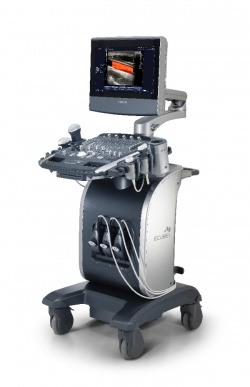Alpinion Medical Systems - Aiming to soar in the league tables
The goals are ambitious: Although in the market merely four years, the start-up firm Alpinion Medical Systems states its intention to become one of the prime providers in the ultrasound mid-range price segment. In an interview with Daniela Zimmermann of European Hospital, Thomas Roth, Alpinion’s Managing Director, explains his corporate strategy and conviction of success.

Alpinion is a rather young player in the ultrasound arena. What makes your products special?
Thomas Roth: ‘Alpinion is indeed a young enterprise. It was founded in 2007 by two engineers who had both been working with leading ultrasound companies for many years. They are now deeply involved in the development of ultrasound systems that focus on a fundamental issue – providing excellent image quality. To achieve this goal, Alpinion uses the very special single crystal technology.
‘We didn’t invent it. Single crystal is being used by other companies; but we did optimise the production process and had our process patented. We use top quality materials and apply innovative procedures. For example, we create crystals that, to date, were only used in high-end products. They allow us to apply single crystal technology in our ultrasound system, which is in the mid-range price segment but offers image quality comparable to a high-end or premium system. We plan to launch a bread and butter product line, meaning the equipment will be affordable, offer outstanding image and processing quality and good ergonomics.’
In which countries do you expect to be successful?
‘In Europe the major customers are in Germany. So we established a subsidiary in southern Germany to support out corporate HQ in South Korea. We want to be present on the European market. Our sales team has been active since earlier this year and has managed to acquire about 80 trade partners in only nine months.’
What feedback have you been receiving from customers?
‘We launched our prototype E-Cube 9 in 2010, at the joint meeting of the Austrian, German and Swiss Societies for Ultrasound in Medicine and also at MEDICA. Feedback was very positive. Our ultrasound system has a great design and offers excellent image quality. Our customers were amazed. That’s our philosophy – to create an ultrasound system with superb image quality.’
Who are your customers -- hospitals or office-based physicians?
‘With our ultrasound system E-Cube 9 we focus on physicians’ practices. However, we’re in the process of developing further products, which will be ready for the market in the first quarter of 2012. One system will be technically less sophisticated than the E-Cube 9 system, one will be superior to the E-Cube 9. In addition we’ll launch a high-end laptop ultrasound system. With these machines we will enter the hospital market.’
The high-end system – what additional features will it offer?
‘The system will provide even better image quality. It will offer features that today are standard in the hospital segment, but so far have not been crucial in the practice segment. I will not divulge more at this point.’
Is the new system also geared towards hospital radiology departments?
‘We’ll tailor this system to different clinical disciplines. Starting out with cardiology is a strategic decision. From day one, we want to show that we have the know-how to develop an interdisciplinary product and we do not need to limit ourselves to a certain medical area or a certain technology. For example, there’s an Asian company that initially focused on gynaecology. Now it’s difficult for this company to conquer the cardiology or internal medicine segment. That’s something we want to avoid by offering cardiovascular products from the very beginning.’
You underline your products’ image quality – does any hard data support your claim?
‘Image quality is a subjective matter and consequently there are no studies. But we get feedback from the users who know the products in the different price segments. They, the users, are the ones who test the Alpinion system and compare it to reference systems or to the high-end systems available in their hospitals. We don’t claim to offer the best image quality in the entire ultrasound market but, compared to systems in the same class, our image quality is one to two classes better.’
What are your goals for the next five years?
‘It’s our strategic goal to become a global multi-modality provider of medical technology. Let me put it this way: We do not want to challenge the big players in the Premier League, but we want to be first or second in the Second Division. Therefore, Alpinion doesn’t only work on diagnostic ultrasound systems. Currently, we are performing the clinical evaluation of interventional ultrasound systems. This is a very interesting and important area, particularly in highly industrialised countries like Germany.
‘In oncology, high-intensity focused ultrasound – HIFU – is increasingly considered to be a viable alternative to radiation therapy. This will be the second pillar of our business -- the third pillar being the transducers that we manufacture ourselves.
‘We also intend to launch further product families in the next five years, either through acquisitions or our own developments, to cover the entire field of diagnostic imaging. We are looking into digital X-ray, MRI, CT and the entire homecare area. That’s a major challenge. We will not be able to develop the entire portfolio ourselves but will look around for suitable partners.’
20.10.2011











